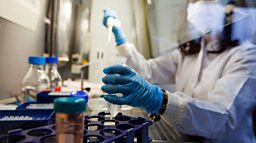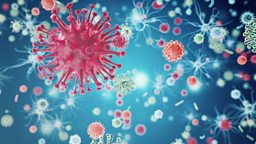Seven things you might not know about the flu virus
2018 is having the worst flu season for seven years. Influenza continues to make a lot of us feel very ill, and it can of course be fatal. Professor Wendy Barclay has been talking on The Life Scientific about how she uses genetics to understand how flu viruses mutate. Here are seven things we've learnt about the flu virus.

1. Viruses are a “borderline” form of life
Viruses like influenza are the simplest form of life that we know of, and are not that far away from being just a collection of genes wrapped in a bubble. They’re so simple, with only ten or so genes (compared to the hundreds of thousands of genes that humans have), that we’re not even sure if they count as being alive, and are often quoted as a borderline case of what constitutes life. Despite this they can still pose a big risk to the human body.
The influenza virus causes infection in the same way as most viruses: invading a body cell in your nose or throat, high-jacking the cell’s machinery, and using that to replicate its own genome. Influenza genes are written in RNA, which is similar to the DNA human cells contain (but for an extra Oxygen atom!), and this is copied and used to make more influenza particles which then leave the host cell to infect more cells, and the cycle continues.
2. The influenza virus is constantly changing
Unlike a lot of viruses, influenza mutates very rapidly, so protection requires a yearly flu jab. It’s a bit of a pain, but it’s very important. Vaccines prepare our immune systems in advance against infection, but since influenza mutates so quickly, over time our body can’t recognise the virus. The flu jab gives our body a yearly update on what influenza is probably going to look like that year.
The surface of the influenza particles is covered in small proteins called hemagglutinin (H) and neuraminidase (N) (which are the ‘H’ and ‘N’ in H1N1 and H5N1, for example). These are the parts that the host body recognises, and keeping these constantly changing has allowed the virus to always stay one step ahead of other creatures’ immune systems. This isn’t the case for all viruses, and that’s why widespread global vaccination has allowed us to completely eradicate the smallpox virus, and very almost polio too.
3. Influenza often crosses over from animal populations
New forms of the flu can sometimes ‘jump’ over from animal populations. This is a rare event, and rarer still that it can then spread throughout humans, which only happened three times in the 20th century and once this century, in the H1N1 swine flu outbreak of 2009-10. Again, researchers are still unsure on how exactly this jump takes place, but it’s clear that there is a need for the virus to mutate in a specific way to cope with the differences between species.
In fact, in the swine flu epidemic, the genes of the aggressive strain were traced back to two viruses from two different continents. These two strains had found their way to southern USA, co-infected a single pig, mixed and matched their genes and gained the ability to infect and transmit in the air through people. This was nigh on impossible to predict and vaccinate against, which is why the epidemic was so widespread.

4. There’s a constant battle to vaccinate
Each year the World Health Organisation (WHO) has the difficult and time-consuming task of predicting which strain of flu to vaccinate against that year. It works with a network of surveillance labs around the globe to pick up on different strains that develop in human and animal populations. Potential strains are evaluated on how fast and far they might spread, how aggressively the infection take hold, and how similar the strain is to vaccines given in previous years.
For the Northern Hemisphere, this decision is made in February to allow time to produce enough of the vaccine to use in the autumn, before flu season gets into full swing. However, this also leaves the chosen strain a lot of time to continue to mutate, which further increases the difficulty of the task. Choosing the right strain to vaccinate against means that the vaccine will reduce chances of infection by 70%.

5. Protecting children can protect whole communities
During the spread of swine flu, health professionals noticed an increase in cases from early May through to the start of July, followed by a drastic drop in cases in the third week of July. This drop coincided directly with the end of the academic year, when schools break up for the summer. Researchers realised that the virus was spreading through communities via their schools, where many children, with underdeveloped immune systems, were in close proximity.
Since then, live attenuated vaccines (a nasal spray vaccine) have been introduced in schools, in order to protect not only the children, but the surrounding community and other vulnerable people within it.
6. Research into influenza has come a long way
A lot of early work on viruses was done following WWII, when infection had been spreading through the cramped conditions of air-raid shelters. The first vaccine for influenza was given to soldiers in 1945, and successfully reduced flu cases in the Army that year – you can imagine their shock when the same vaccine completely failed when used two years later in 1947. Research back then involved getting some healthy volunteers, exposing them to the virus of interest, and then seeing what happened – all with a very scientific mind-set of course.
These days, research is often done using what’s called reverse genetics. This involves sequencing a virus’ genome, using that to generating its RNA from scratch and adding it to cells, which then produce thousands of viral particles. This allows researchers to tweak the virus, and see which parts of the genome make them more or less lethal, as well as help design vaccines to use against them.
7. Looking for a universal vaccine
The dream in influenza research is the invention of a Universal Influenza Vaccine – a vaccine that can be given just once, and provide year on year protection against the flu. Obviously, this has been a big hurdle for the last half a century, and it’s still a long way off, but many are sure it’s not an impossible goal, only a very difficult one. A universal vaccine would rely on targeting a part of the virus that doesn’t change much, but that’s not how vaccines are usually designed; it would really require a rethink of how we design and produce vaccines on a whole. Despite this, work is chugging away in this area, with one team going to clinical trials in 2018, although even if that’s successful it would still be quite a while before we see anything like a Universal Influenza Vaccine.

-
![]()
The Life Scientific
Jim Al-Khalili discusses the flu virus with Professor Wendy Barclay of Imperial College.
-
![]()
Seven ways to deal with winter
From moisturising to keeping hydrated, some simple steps to combat winter blues.
-
![]()
What happened to the Aztecs?
Were the Aztecs wiped out by disease introduced by the invasion of Europeans?
-
![]()
What's in a doctor's bag?
Dr Mark Porter demystifies the doctor's bag.




